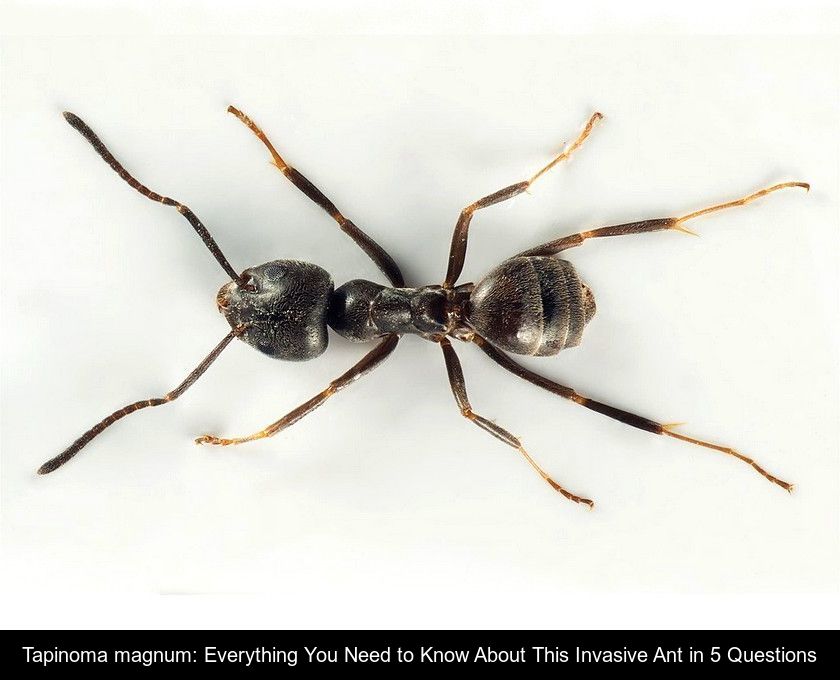Tapinoma Magnum: Everything You Need To Know About This Invasive Ant In 5 Questions
It is often referred to as the Corsican ant. And yet, the species Tapinoma magnum is not native to the Isle of Beauty. This insect is a real scourge for residents in the regions where it has settled. We offer you everything you need to know about this invasive ant in 5 questions.
1- What is the origin of the ant Tapinoma magnum?
The media often refer to them as Corsican ants, but the representatives of the species Tapinoma magnum are not endemic to the Isle of Beauty.
This ant species is native to the Mediterranean basin and only arrived in Corsica in 2020. It was probably imported to the island from the Maghreb, along with plants or compost via nurseries.
2- How to recognize the Tapinoma magnum ant?
Tapinoma magnum ants are black in color and measure an average of 3 mm. In winter, they hide underground and then reappear as soon as the warm days arrive.
The most reliable way to recognize them is by their smell. When crushed, they emit a very strong rancid butter odor.
They are also distinguished by their aggressiveness towards other ant species... and humans! People whose gardens are invaded have to wear rubber boots to garden because these invaders bite.
3- Is the bite of Tapinoma magnum dangerous?
The only good news about the ant Tapinoma magnum is that this species is not venomous.
Its bites are unpleasant but harmless, as this Mediterranean ant does not have venom.
4- What is the problem with Tapinoma magnum?
Even though this ant is harmless to human health, it is a real scourge for the environment and for residents wherever it settles.
It is indeed an invasive species that reproduces much faster than most other ants and creates giant colonies. These ants are also very resilient and no product, natural or chemical, seems to be able to stop them. In fact, after appearing in Corsica in 2020, they are gradually colonizing the west of France.
In nature, Tapinoma attacks gardens, fruit trees, and insects, including other species of ants that it hunts. But the worst part is that it sneaks into houses through cracks and gets everywhere, even into baseboards.
These ants are omnivorous and appear as soon as a crumb of food falls to the ground. They feed on anything lying around, including cat kibble!
5- How to get rid of Tapinoma magnum ants?
Currently, there is no simple and effective treatment available to combat the invasion of Tapinoma magnum ants. Residents in Corsica and other regions of France, exasperated by these invaders, tend to worsen the problem. Indeed, the more one tries to get rid of this insect, the more it resists!
Insecticidal powders and sprays are ineffective against this Mediterranean species and even counterproductive. These products destroy local ants, which facilitates the proliferation of Tapinoma magnum. In summary, by trying to destroy this invasive ant, you help it expand its empire by eliminating other types of insects that compete with it.
Climate change also favors this ant, which thrives in hot, dry, and low-biodiversity environments. This is why specialists believe it is no longer possible to completely eradicate this invasive species.
However, this does not mean you should give up. You must not let it develop freely because the more it invades a region, the more it creates an environment favorable to itself. Since 2018, research has been underway at the University of Corte to develop natural repellents.
While waiting for effective treatments to become available on the market, you can limit the invasion of Tapinoma magnum in your garden and around your home by adopting some good practices:
• Identify and treat only the anthills to target Tapinoma without harming other insects.
• Preferably intervene in winter and scald them with hot water if you spot a nest while digging your land.
• Promote biodiversity in your garden by, for example, avoiding mowing the lawn too short.
• Attract birds to your garden as some birds are natural predators of these ants.
• Fight against drought, which also contributes to the development of this ant.









